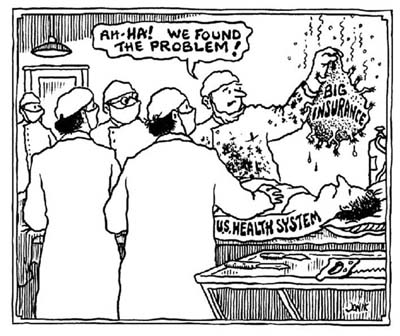Healthcare-NOW!
Single-payer is a term used to describe a type of financing system. It refers to one entity acting as administrator, or “payer.” In the case of healthcare, a single-payer system would be setup such that one entity—a government run organization—would collect all healthcare fees, and pay out all healthcare costs.
In the current US system, there are literally tens of thousands of different healthcare organizations—HMOs, billing agencies, etc. By having so many different payers of healthcare fees, there is an enormous amount of administrative waste generated in the system. (Just imagine how complex billing must be in a doctor’s office, when each insurance company requires a different form to be completed, has a different billing system, different billing contacts and phone numbers—it’s very confusing.)
In a single-payer system, all hospitals, doctors, and other healthcare providers would bill one entity for their services. This alone reduces administrative waste greatly, and saves money, which can be used to provide care and insurance to those who currently don’t have it.
Access and Benefits
Everyone would receive comprehensive medical benefits under single-payer. Coverage would include all medically necessary services, including rehabilitative, long-term, and home care; mental healthcare, prescription drugs, and medical supplies; and preventive and public health measures.Care would be based on need, not on ability to pay.
Payment
Hospital billing would be virtually eliminated. Instead, hospitals would receive an annual lump-sum payment from the government to cover operating expenses—a “global budget.” A separate budget would cover such expenses as hospital expansion, the purchase of technology, marketing, etc.Doctors would have three options for payment: fee-for-service, salaried positions in hospitals, and salaried positions within group practices or HMOs. Fees would be negotiated between a representative of the fee-for-service practitioners (such as the state medical society) and a state payment board. Government would serve as administrator, not employer.
Financing
We propose an equitable financing program in which everyone pays their fair share. Under this program, all employers and employees will pay a modest payroll tax. This will produce a dramatic savings for those responsible private employers and state and local governments which currently purchase health insurance for their employees. By drawing on the immense wealth that has accrued to the richest Americans and large corporations over the past 25 years, 95% of people will pay less for their healthcare than they are currently paying. Some of the key components to financing HR 676:- Eliminates all employer contributions to private insurance premiums—replacing them with a modest payroll tax of 4.5% (in addition to the 1.45% currently paid towards Medicare).
- Eliminates all individual premiums, co-pays, deductibles and nearly all other out-of-pocket costs—replacing them with a modest payroll tax of 3.3% (in addition to the 1.45% currently paid towards Medicare).
- Relieves state and local governments of the immense burden of paying insurance premiums for medical coverage for their current and retired employees—replacing them with a modest payroll tax of 4.5% (in addition to the 1.45% currently paid towards Medicare).
Administrative Savings
The General Accounting Office projects an administrative savings of 10 percent through the elimination of private insurance bills and administrative waste, or $150 billion in 2002. This savings would pay for providing medical care to those currently under served.Cost Containment
A 2004 economic study published in The New England Journal of Medicine determined that a national single-payer healthcare system would reduce costs by more than $400 billion a year despite the expansion of comprehensive care to all Americans. No other plan projects this kind of savings.Different Perspectives on the Benefits of Single-Payer
Patients
Each person, regardless of ability to pay would receive high-quality, comprehensive medical care, and the free choice of doctors and hospitals. Individuals would receive no bills, and copayment and deductibles would be eliminated. Most people would pay less overall for health care than they pay now.Doctors
Doctors’ incomes would change little, though the disparity in income between specialties would shrink. The need for a “wallet biopsy” before treatment would be eliminated; time currently wasted on administrative duties could be channeled into providing care; and clinical decisions would no longer be dictated by insurance company policy.Medical endorsements include the California Nurses Association/National Nurses United (160,000), PNHP (9,000), the American Public Health Association (30,000), American Association of Community Psychiatrists, Massachusetts Academy of Family Practice, American Medical Women’s Association (13,500), Alameda-Contra Costa Medical Society, American Medical Student’s Association, D.C. Medical Society, National Medical Association (6,500), American College of Physicians (Illinois Chapter), Long Island Dermatological Society, Islamic Medical Association, the Nurses’ Network for a National Health Program, and the D.C. chapter of the American Medical Association.
Hospitals
The massive numbers of administrative personnel needed to handle itemized billing to 1,500 private insurance companies would no longer be needed. A negotiated “global budget” would cover operating expenses. Budgets for capital would be allocated separately based on healthcare priorities. Hospitals would no longer close because of unpaid bills.Insurance Industry
The need for private insurance would be eliminated. One single payer-bill currently in the House (H.R. 1200) would provide one percent of funding for retraining displaced insurance workers during its first few years of implementation.Business
In general, businesses would see Single-Payer limit their health costs and remove the burden of administering health insurance for their employees. Read more about how single-payer helps small business in our Small Business Brochure.Congress
Single-payer would be the simplest and most efficient healthcare plan that Congress could implement. It would be based Medicare, one of the most successful national healthcare programs.






